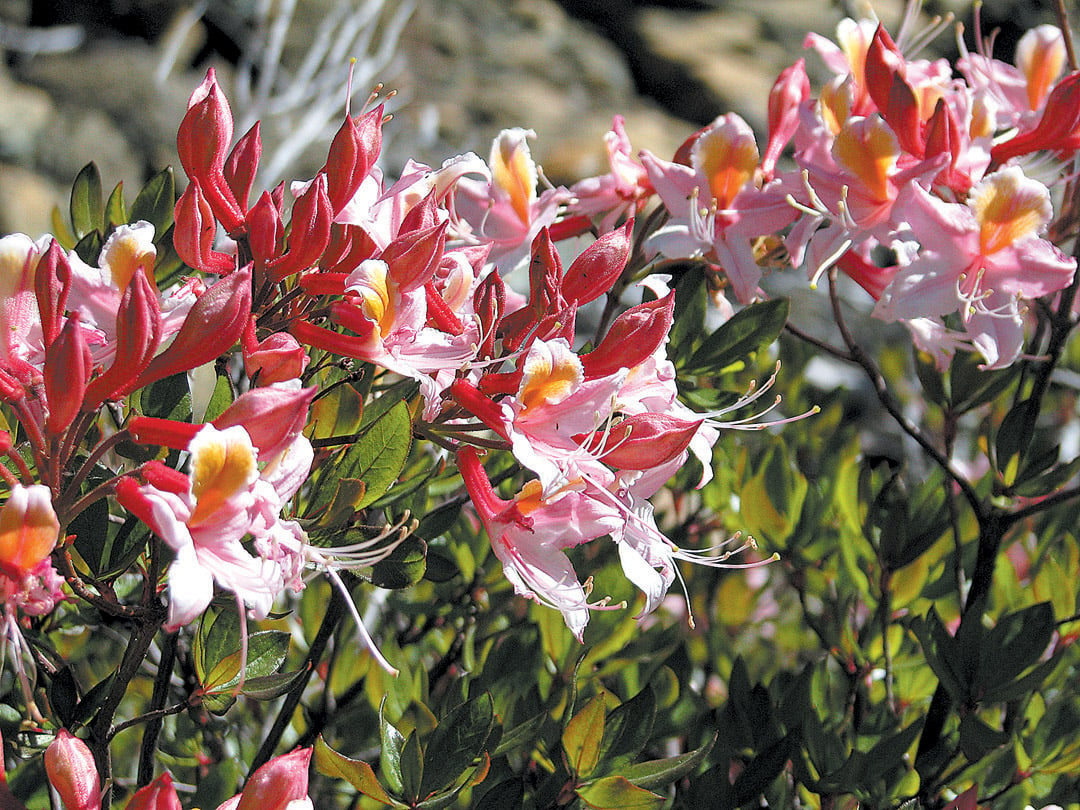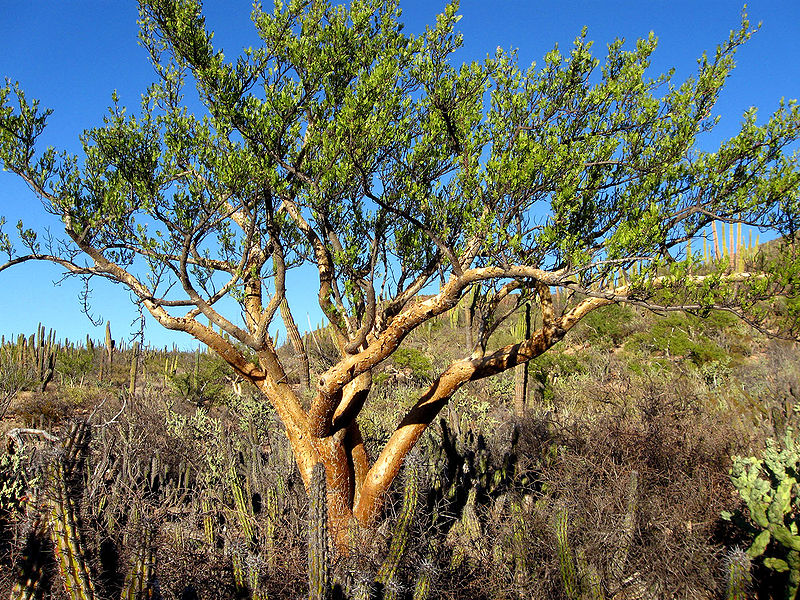

Contributor
- Topics: Archive, Plants You Need

The western azalea (Rhododendron occidentale) is one of only two species of rhododendron native to the West Coast of North America. it was the inspiration for the Pacific Horticulture logo, which was designed in the 1970s by artist Wynn Hayakawa, daughter of the late Margedant Hayakawa, a founding board member and former president of Pacific Horticultural Foundation.
Western azalea (Rhododendron occidentale) is a plant of great beauty and captivating fragrance that appeals to virtually everyone who comes upon it. The large floral trusses are visually compelling by any standard: five to fifteen, sparkling white or pink, flaring trumpetshaped flowers, marked with a bright yellow to orange spot. The air around the flowers— indeed an entire canyon—can be delightfully fragranced with a sweet and spicy clove scent reminiscent of cottage pinks and carnations. The flowers emerge before the leaves, bestowing maximal effect.
The flowers are set atop an attractively branched deciduous shrub, usually four to twelve feet tall, although small, tree-like groves over fifteen feet tall can sometimes be found. The primary branching tends to be strongly upright, creating thickets that are slightly vase-shaped and open at the base. The secondary branching is clustered, usually originating as whorls but typically becoming irregularly arranged with age. Thus, the shrubs have a strong structure of primary branches, with an attractive, rather intricate upper branching that lends a craggy, billowy effect. Western azalea, like many Western shrubs, has the capacity to resprout from the ground if the top has been destroyed by fire, landslides, flooding, or other catastrophe, as long as the root system remains intact.
The foliage emerges a bright shiny green; the leaves are oval to obovate (wider toward the top) and end in a bluntish point. The primary veins are sunken a bit, which gives more texture to the surface, while the margins tend to curl back, creating a more sculptural, three-dimensional effect. New leaves—as with buds, pedicels, and seed capsules—are covered with oily glands that have a spicy/skunky odor up close; these glands tend to fall off as the season progresses. In late autumn, the leaves typically turn a golden yellow, though orange and deep scarlet also occur. There is a direct correlation between the deepness of any pink coloration in the flower and the red component in autumn foliage.

A Western Endemic, with a Serpentine Connection
Western azalea is native to California and Oregon, west of the Cascades, and inhabits a variety of habitats; access to perennial moisture for the roots is perhaps the single linking character. It is most abundant in north western California and southwestern Oregon, occurring in foggy coastal scrub, inland around springs and seepages and along creeks and rivers; it extends, in elevation, up to moist mountain meadows. Many who admire this elegant shrub have first seen it gracing streamsides and damp openings in the coast redwood (Sequoia sempervirens) forests of Northern California, where it is a welcome sight in late spring or early summer. Probably an equal number have enjoyed its festive and fragrant blooms while hiking mountain trails, where it frequently edges damp meadows, lakesides, and creek margins.
Although I have seen western azalea in many habitats from coastal bluffs to 8,000-foot mountain meadows, my most frequent encounters are on areas of ultramafic (high iron and magnesium) rock, commonly called serpentine. Serpentine substrate has been of great interest to me over the last three decades, and Rhododendron occidentale seems to love it too, so we intersect repeatedly. My partner, David McCrory, and I bought a large parcel of a deep canyon of serpentine rock in Sonoma County called The Cedars, where western azalea dominates the stream banks and riparian corridors. Each spring, many of the field trips I lead into this unique and botanically rich area are planned around the azalea’s flowering season; I have yet to meet someone who dislikes it.
Part of the visual drama of these azaleas on serpentine is the unexpected contrast between what looks like a delicate, flowering shrub and the harsh, often barren serpentine landscape on which it is displayed. The effect is strange and almost unbelievable—but powerful. After nearly three decades, it still takes my breath away each time I see it.

Flower and Fragrance
The flowers vary considerably in color from nearly pure white through deep rosy pink—all with a large golden spot on the inside of the upper petal. For those flowers with pink coloration, the color is strongest on the outside of the bud, some being nearly red, whereas the interior coloration is softer, often irregular in patches or streaks. The buds, alone, are attractive as they expand, forming bloated pouches just before opening—reminiscent of the inflated buds of balloon flower (Playtcodon). Each cluster of buds is actually formed at the end of the previous summer, as is common in many members of the heather family (Ericaceae). These nascent inflorescences hint at how showy the next season’s flowering will be, though other environmental factors may still influence the subsequent flowering.
As the bud cluster expands in spring, the numerous enlarging buds point mostly upward, but curl outward as they open fully. In early flowering, the contrast between the deep bud colors and the fully open flowers surrounding them is bold and appealing. The inner surface of the flower petals is bright and shimmering with a sort of “diamond-dusted” look. The margins of the petals can be slightly or highly crisped, with petal tips recurved. The floral coloration, whether solid or irregular, deepens toward the base of the flowers, where the petals are fused into a tube. Five long curving stamens and a pink-tinted style project elegantly outward beyond the petals—the whole creating the look of an exploding star, or perhaps, with its face-like blotch, a cartoon star rushing toward you.
Within most populations, variation appears primarily in the flower color. Petal width, the degree of petal overlap, and the waviness of the petal margins are the other typical variables. Some shrubs put out a second but weaker flush of bloom in fall and winter months. It is uncertain whether this is genetic in character or environmental; regardless, it is an unexpected treat. There are a few natural populations where extreme variations occur, but these are quite rare. The Stagecoach Hill site, on the Humboldt County coast, is one of the best-known areas of extreme variation. [This population of western azalea was studied by Britt Smith and Frank Mossman, who wrote about it in the Spring 1977 issue of Pacific Horticulture, which is now available online at www.pacifichorticulture.org. See also Richie Steffen’s article on page 43.]
And all the while that you are admiring the floral detail, you are engulfed in its perfume. On still days, especially toward dusk, waves of fragrance-laden air can literally be felt cascading down hillsides or canyon slopes. This combination of attractive shrub, gorgeous flowers, and heady aroma make encounters with this plant truly memorable.

A Challenging Garden Plant
With so much to like about this western shrub, it naturally appeals to many as a potential garden subject. You would think everyone wishing to emphasize the horticultural value of our native flora would have western azalea growing somewhere in their gardens. Unfortunately, it is not particularly easy in cultivation, at least not in California, as I found working at the UC Botanical Garden in Berkeley, where I tended the California natives for nearly a quarter of a century. One of the most frequent queries I received from native plant enthusiasts was, “How do you grow western azalea?”
There is no simple answer, but I can provide some suggestions for success. The first is to be patient, as Western azalea is a slow growing shrub. The second is to provide routine moisture. In the wild, although some plants appear to be growing out of arid rock crevices, they always have their roots in moisture, typically moving water. This non-stagnant water maintains a cool root zone—the third requirement. In a garden, this can be approximated by shading the root zone with a deep mulch, protecting plants from the hot afternoon sun, or providing cool moving water.
The most common ailment is mid- to late summer mildew on the leaves; this can be so widespread that some may have the impression the summer foliage color is silver. In the wild, those that don’t get mildew are generally out in the open, in areas with hot dry air. Thus, excellent air circulation is crucial in a garden setting: avoid “dead air” spaces under eves, or among crowded understory plantings. While the plants can tolerate considerable shade they need to have their leaves in moving air. Keep the dampness in the root zone, not around the foliage.
In the wild, western azaleas may seem to defy the need for humus-rich soils that most rhododendrons prefer. In cultivation, however, providing these conditions will result in better and faster growth. Propagation can be from seed or by cuttings, especially with unusual forms; cuttings generally work well when taken from firm new growth. The redness that shows in the seedling stage will be reflected in future flower color and fall leaf color.
If you are fortunate enough to have Western azaleas growing naturally on your property, your primary maintenance chore will to be to prevent neighboring vegetation from crowding out your azaleas. In the absence of routine fire, many conifers tend to seed into azalea thickets and can eventually shade them into oblivion. Don’t let this happen!
Give this lovely western native shrub a try; if successful, it will be a thrilling addition to your garden. And visit some of the natural habitats where it occurs to enjoy the beauty and variation of western azalea in the wild.
Share:
Social Media
Garden Futurist Podcast
Most Popular
Videos
Topics
Related Posts

Ground Up Science for Greener Cities with Garden Futurist Dr. Alessandro Ossola
Spring 2023 Listen to the Podcast here. Alessandro Ossola is a scientist who gets very excited about the challenge of climate change allowing for an

Readying Urban Forests for Climate Realities with Garden Futurist Dr. Greg McPherson
Winter 2023 Listen to the Podcast here. “Going from the mow and blow to a more horticulturally knowledgeable approach to maintaining the landscape. And that

Welcome, Greywater, to the Garden
Summer 2022 Oh, summer: delightful warm air, tomatoes swelling on the vine, fragrant blooms on an evening stroll. When it’s warm and rainless, how is

Big Tree-Data and Big-Tree Data with Garden Futurist Matt Ritter
Summer 2022 Listen to the full Garden Futurist: Episode XV podcast here. We are in an environmental crisis right now in many parts of California









Responses